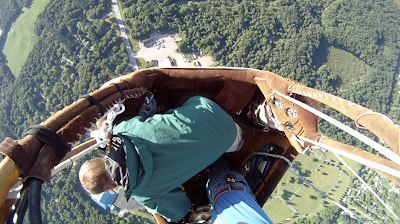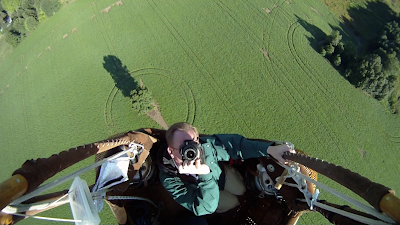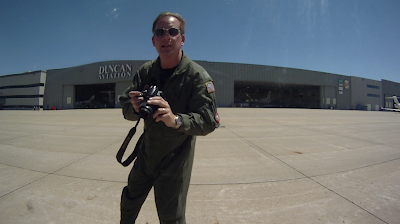First Frame Grabs from the T-38 Talon Ride
On the Eve of the Talon Ride

This is a regular blog entry. If you’re looking for show notes or liks to show audio or video, please check out the other entries.
Many thanks to Jo Hunter (www.futurshox.net) for shooting the stills in this entry and to Mark LaCoste for shooting video and providing really valuable Air Force background and commentary from his experiences as an F-15 Eagle maintainer.
Okay, I’m going on radar. (It seems as though I’ve been using that line frequently lately!)
I’ve been here at Beale AFB, about 45 minutes north of Sacramento, since Sunday afternoon. This morning, I completed my flight physical. That’s the last hurdle over which I have any control and thus the event after which I go on radar with you guys. So I can tell you that I’m on the verge of completing the trifecta: Completing demo rides in examples of aircraft from each phase of the fighter-bomber track.
As most of you know, I have logged time in the T-6A and the F-16. That leaves only the Phase 3 aircraft – In this case, the mighty T-38 Talon. I’ve been working with the 9th Reconnaissance Wing for a few months to get things lined up and now it’s scheduled to happen tomorrow. I show at 1345 local and step at 1530 local for an approx. 1.5-hour flight.
Today was mostly preliminaries. I got the flight physical done and then did a base tour. After lunch, it was time for the egress training, parachute training, survival kit orientation, and local survival training.

The egress training is always the most interesting of the pre-flight activities. You have a training cockpit and you learn how to get in, strap in, get the canopy closed, and be ready to fly. Then it’s all about emergency procedures. You learn how to egress (get the hell out of the airplane on the ground in case of fire or other danger) and how to eject.
Capt Gorman walked me through the egress training first, and then I climbed in and demonstrated my understanding. It takes doing it two or three times to figure out what you’re doing, but it comes pretty quickly if you’ve paid attention.

Then it’s all about the parachute. We walked through what to expect in an ejection and how to recognize and troubleshoot parachute malfunctions. Probably the most interesting part came with the personal lowering device (or “PLD”). The idea is that you might make it from 15,000 ft. AGL to 50 AGL just fine, but be hung up in a tree and need to get yourself the rest of the way down unassisted. With the PLD, you can do just that but connecting it to a tree branch or (if your parachute is firmly lodged in the tree) the parachute itself and then pulling the harness releases and lowering yourself with a breaker bar.
I actually got to perform the whole procedure suspended from the ceiling. For the record, it was pretty straightforward and I think I accomplished it with aplomb. One demonstrated parachute landing fall later, I was signed off and the pre-flight training was complete.
Next was life support for the G-suit, helmet, and mask. This is my third time getting fitted for this equipment. Although the fittings have been roughly a year apart, I’m pleased to report that it seems that I remember perfectly well how to don and doff a G-suit. And a helmet and mask. And check out the breathing apparatus at the test station. Not that I’m anywhere close to being a fighter jock. But it gets the heart beating a little quicker when you walk into a place like the base life support room and it turns out that you know what to do.

So, in the quiet and dark of yet another locker at yet another Air Force base, there sits another G-suit, helmet, and mask. And they have my name associated with them. Tomorrow I again get to taste a little bit of that fleeting dream that began in 1971 with a book about Joe McConnell, Jr. and the F-86 Sabre. Tomorrow I step to complete the trifecta. And maybe I get a little closer to understanding what lives inside every pilot and aviation enthusiast.
And, most of all, I hope that I again feel that spark that will keep me up at night for the next couple of months composing, editing, writing, and bringing you guys another account from the edge of the envelope.
G’night for now. Sleep if you can. I’m going to go toss and turn for awhile. Wouldn’t you?
Invertor et vomens! Smoke on!
Frame Grabs from Friday’s Balloon Flight
BAC Strikemaster Gun Cam Frame Grabs
Battle Creek 2010 – Media Day

Yeah! It’s Battle Creek time again! The Battle Creek Field of Flight Airshow and Balloon Festival is going on now through Sunday in Battle Creek, Michigan.
I spent the day on the field (when I wasn’t up in a balloon) and shot stills and video and caught up with my friends there. And, naturally, I got a preview of the attractions this year.
Randy Harris of Bearfoot Aerobatics really flies beautifully. I think his Skybolt 300 is one of the most photogenic airplanes on the field this year. It was really catching the sun today in a way that not a lot of aircraft do (especially when you consider where the sun is when you’re facing north on a crowd line but the acro is flown along Runway 5-23 – You have very narrow angular area where the sun makes it worthwhile to shoot). The airplane puts out a lot of smoke, too, which makes the presentation even more dramatic.

The F-22 Raptor is headlining the show this year. It’s no secret that I’m a huge raptor fan and I got up close and personal with both of the specimens that were on the ramp. David “Zeke” Skalicky, Maj, USAF, is flying the Raptor this year and he put her through her paces. I can do some of that stuff in a Citabria, but I have to do it at 60 KIAS and then I have to recover from the ensuing spin. The handling is just too sweet for words. My only complaint is that the aircraft doesn’t come in a two-seat variant.
The Raptor is flying with a F-4 Phantom II for the heritage flight. I’ve never been a Phantom fan because I’ve always seen it as a misguided foray away from the core Boydian energy-maneuverability philosophy that makes this kind of flying worthwhile. The Phantom was a missiles-only ship for most of its operational service life. Only later did they add the gun. Maybe the Raptor (which is about as automated an aircraft as we have that still has a seat in it and fights BVR and drops JADAM) ) is the more proper expression of what the Phantom’s designers had in mind.
I’m hopelessly romantic about the idea that one ought to crank and bank and engage in combat where the actual maneuvers of the airplane matter. Regardless of whether the Raptor fights BVR, it can move like nothing else out there and perhaps there’s poetry in flying the Phantom in the formation – Maybe the Raptor is the redemption of the Phantom. Or maybe I’m full of crap. Either way, the Raptor is much more fun to watch than the Phantom. Even if the Phantom has two seats.

I interviewed the safety officer for the demo team in front of the airplane for Airspeed and Acro Camp. It was a good interview and he was enthusiastic about the airframe. I need to get his name from his tag in the video. The team was ready to brief the demo and the captain was very kind to take a few minutes to do the interview at that point in the day. I don’t have the hardware to pull the video off the cards here in Battle Creek, so it’ll have to wait until I get back the Airspeed HQ.
Last thing about the Raptor. I know that everyone thinks that a jet team like the Thunderbirds of the Blues is necessary to anchor an airshow. And nobody loves jet teams more than I do. But I think that the F-22 is a wholly satisfying anchor demo for an airshow. For the reasons stated above and because it gives the show an opportunity to really craft the mix of other acts on the schedule. This is a really satisfying airshow with 100LL and JP-8 burners and pyro and other elements. I’m really looking forward to watching this tomorrow with a crowd pressed up against the snow fence.

The Iron Eagle Aerobatic Team was also there to play. Formation acro is just such a quantum leap from single-ship acro. And these guys get really close and match each other so nicely. It’s just a joy to watch. Satisfying prop whine, lots of smoke, and dramatic coverage of the show line. What’s not to like?

Bob Carlton demonstrated some truly beautiful stuff in his Super Salto. It’s a sailplane powered by the PBS TJ-100 jet engine that puts out 225 pounds of thrust, which is more than enough to aloow the sailplane to self-launch and makes it the only sailplane on the airshow circuit capable of performing a low-level, jet-powered airshow program. I didn’t expect to enjoy Bob’s routine as much as I did. Maybe it’s the same thing I feel when I’m watching John Mohr or Greg Koontz. Although the Super Salto has a jet engine, it’s not that powerful and I’d imagine that it requires some pretty good pilot chops and attention to energy management to make it do the things that Bob makes it do.













